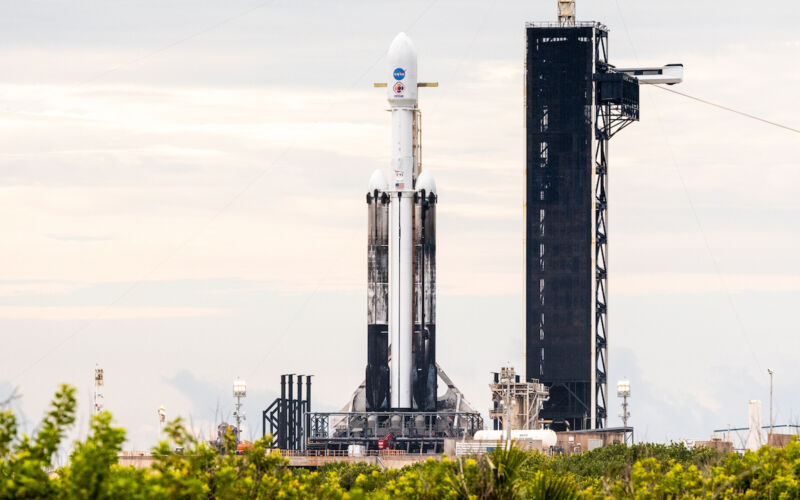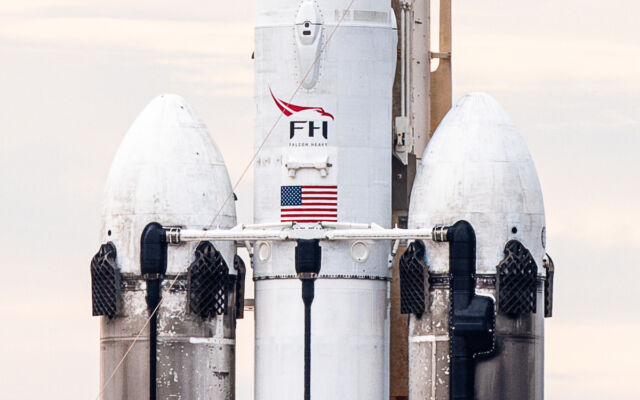
Enlarge / NASA’s Psyche spacecraft is cocooned inside the payload shroud on top of SpaceX’s Falcon Heavy rocket.
Trevor Mahlmann/Ars Technica
A roughly 3-ton spacecraft is ready for launch Friday from NASA’s Kennedy Space Center in Florida to begin a six-year trip to an enigma in the asteroid belt, an unusual metallic world the size of Massachusetts that could hold clues about the formation of Earth and other rocky planets.
This mission, named Psyche, will survey its namesake asteroid for at least 26 months, moving to different altitudes to map the metal world with three science instruments. Like all missions exploring the Solar System, the Psyche spacecraft has a long journey to reach its destination, covering some 2.2 billion miles (3.6 billion kilometers) with the help of plasma engines.
No one knows what the spacecraft will find when it reaches the asteroid Psyche. The best images of the asteroid captured through telescopes only show Psyche as a fuzzy blob a few pixels wide. Scientists know it is dense and at least partially made of metal, primarily iron and nickel. The leading hypothesis among Psyche’s science team is that the asteroid is likely a leftover remnant from the early history of the Solar System 4.5 billion years ago, the exposed core of a failed planet that may have had its outer layers of rock blasted away during collisions with other objects in that chaotic time.
“That’s the real excitement for me,” said Lindy Elkins-Tanton, the mission’s principal investigator from Arizona State University. “We don’t know what it’s going to look like. We’re going to be surprised. We’re going to learn something new about a fundamental building block for rocky planets, that is, their metal cores.”
The first leg of Psyche’s interplanetary voyage is set to begin at 10:19 am EDT (14:19 UTC) with liftoff of a SpaceX Falcon Heavy rocket from Florida. This will be SpaceX’s first Falcon Heavy launch for NASA, which plans to use the heavy-lifter for more critical missions in the coming years.
You can watch NASA’s live coverage of the launch below, beginning at 9:30 am EDT.
There’s a 50 percent chance of good weather for launch Friday. The Psyche mission has until October 25 to get off the ground, taking advantage of an alignment of the planets to enable its entry into the asteroid belt between Mars and Jupiter.
Psyche will get a booming blastoff from the Falcon Heavy rocket, with 27 kerosene-burning engines providing an initial boost out of the atmosphere. The rocket’s two reusable side boosters will detach and return to land at Cape Canaveral, where SpaceX will refurbish the rockets for another flight next month on a Falcon Heavy rocket for the US Space Force. Then, notably, SpaceX will set them aside to fly a final time next October with a Falcon Heavy rocket on another NASA mission, Europa Clipper, to explore an icy moon of Jupiter.

Enlarge / The Falcon Heavy’s two side boosters bear the marks of three previous flights to space. The rocket’s core stage is new.
Trevor Mahlmann/Ars Technica
After separation of the side boosters, Falcon Heavy’s core stage will throttle up to burn another minute-and-a-half. Then an upper stage will release from the core stage, taking over for two engine firings to accelerate the Psyche spacecraft with enough velocity to escape the grip of Earth’s gravity. The Psyche spacecraft will deploy from the rocket about an hour after liftoff, then extend its power-generating solar arrays to a span of 81 feet (about 25 meters) end to end. Within a couple of hours, ground controllers at NASA’s Jet Propulsion Laboratory in California expect to establish a stable communication link with Psyche to verify all’s good with the spacecraft.
“The spacecraft is completely ready to go,” said Henry Stone, Psyche’s project manager at JPL. “It’s been fueled. It’s been integrated onto the rocket. The rocket is now upright and vertical. The final version of flight software has already been loaded on the vehicle. The final set of flight parameters that are necessary for launch have been loaded, so it’s ready to go. The only thing that stands in our way is the weather.”
>>> Read full article>>>
Copyright for syndicated content belongs to the linked Source : Ars Technica – https://arstechnica.com/?p=1975180

















![[News] Japan Develops 10nm Nanoimprint Technology, with Potential to Tackle EUV Bottleneck – TrendForce](https://earth-news.info/wp-content/uploads/2025/12/329851-news-japan-develops-10nm-nanoimprint-technology-with-potential-to-tackle-euv-bottleneck-trendforce-360x180.jpg)













